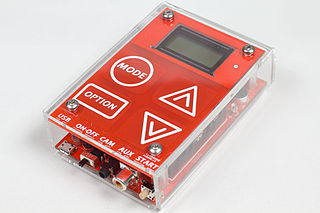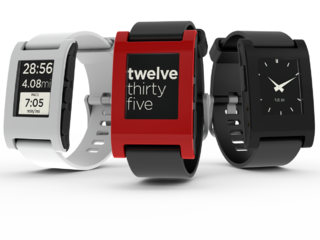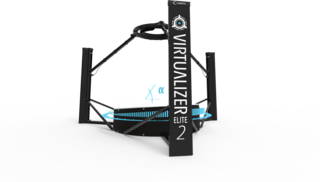Related Research Articles

The Defense Advanced Research Projects Agency (DARPA) is a research and development agency of the United States Department of Defense responsible for the development of emerging technologies for use by the military.

A camera phone is a mobile phone which is able to capture photographs and often record video using one or more built-in digital cameras. It can also send the resulting image wirelessly and conveniently. The first commercial phone with color camera was the Kyocera Visual Phone VP-210, released in Japan in May 1999.
A carbon dioxide sensor or CO2 sensor is an instrument for the measurement of carbon dioxide gas. The most common principles for CO2 sensors are infrared gas sensors (NDIR) and chemical gas sensors. Measuring carbon dioxide is important in monitoring indoor air quality, the function of the lungs in the form of a capnograph device, and many industrial processes.

An electronic nose is an electronic sensing device intended to detect odors or flavors. The expression "electronic sensing" refers to the capability of reproducing human senses using sensor arrays and pattern recognition systems.

The Micro Four Thirds system is a standard released by Olympus and Panasonic in 2008, for the design and development of mirrorless interchangeable lens digital cameras, camcorders and lenses. Camera bodies are available from Blackmagic, DJI, JVC, Kodak, Olympus, Panasonic, Sharp, and Xiaomi. MFT lenses are produced by Cosina Voigtländer, DJI, Kowa, Kodak, Mitakon, Olympus, Panasonic, Samyang, Sharp, Sigma, SLR Magic, Tamron, Tokina, TTArtisan, Veydra, Xiaomi, Laowa, Yongnuo, Zonlai, Lensbaby, Kowa, Venus Optics and 7artisans amongst others.

Wearable technology is any technology that is designed to be used while worn. Common types of wearable technology include smartwatches and smartglasses. Wearable electronic devices are often close to or on the surface of the skin, where they detect, analyze, and transmit information such as vital signs, and/or ambient data and which allow in some cases immediate biofeedback to the wearer.

Kickstarter is an American public benefit corporation based in Brooklyn, New York, that maintains a global crowdfunding platform focused on creativity. The company's stated mission is to "help bring creative projects to life". As of February 2023, Kickstarter has received $7 billion in pledges from 21.7 million backers to fund 233,626 projects, such as films, music, stage shows, comics, journalism, video games, board games, technology, publishing, and food-related projects.
Dexter Industries is a company that designs robots for education, research, and personal use. The company makes several products that expand the LEGO Mindstorms, Raspberry Pi, and Arduino prototype system.

A body area network (BAN), also referred to as a wireless body area network (WBAN) or a body sensor network (BSN) or a medical body area network (MBAN), is a wireless network of wearable computing devices. BAN devices may be embedded inside the body as implants or pills, may be surface-mounted on the body in a fixed position, or may be accompanied devices which humans can carry in different positions, such as in clothes pockets, by hand, or in various bags. While there is a trend toward the miniaturization of devices, in particular body area networks which consist of several miniaturized body sensor units (BSUs) together with a single body central unit (BCU), larger decimeter sized smart devices still play an important role in terms of acting as a data hub or data gateway and providing a user interface to view and manage BAN applications, in-situ. The development of WBAN technology started around 1995 around the idea of using wireless personal area network (WPAN) technologies to implement communications on, near, and around the human body. About six years later, the term "BAN" came to refer to systems where communication is entirely within, on, and in the immediate proximity of a human body. A WBAN system can use WPAN wireless technologies as gateways to reach longer ranges. Through gateway devices, it is possible to connect the wearable devices on the human body to the internet. This way, medical professionals can access patient data online using the internet independent of the patient location.

Triggertrap was a company that created hardware and software products centred on triggering SLR cameras. Products included several Arduino-based camera triggers, along with mobile apps which interfaced with cameras using a device that plugs into the headphone socket of the smartphone or tablet. In May 2012, Triggertrap introduced Triggertrap Mobile for iOS, followed by a version for Android in September 2012. Triggertrap Mobile utilized the sensors and processing power of a smartphone or tablet running IOS to trigger cameras based on sound, motion, vibration, or location, in addition to timelapse, bulb ramping, and other features. Triggertrap ceased trading on the 31st of January 2017. The founder and CEO was the Dutch photographer Haje Jan Kamps.

Pebble is a discontinued smartwatch developed by Pebble Technology Corporation. Funding was conducted through a Kickstarter campaign running from April 11, 2012, to May 18, 2012, which raised $10.3 million; it was the most funded project in Kickstarter history, at the time. Pebble began shipping watches to Kickstarter backers in January 2013. Pebble watches can be connected to Android and iOS devices to show notifications and messages. An online app store distributed Pebble-compatible apps from many developers including ESPN, Uber, Runkeeper, and GoPro.
NODE+ is a first-generation handheld sensor measuring 1 inch in diameter and 3.75 inches wide that communicates wirelessly through low-energy Bluetooth 4.0 with Apple iOS devices.

The Virtualizer is a series of omnidirectional treadmills for virtual reality applications. The treadmills have integrated sensors for motion detection of the user. The products are being developed, manufactured and sold by the Austrian company Cyberith GmbH.
The Air Quality Egg (AQE) is an Internet of Things platform and hobbyist device for crowdsourced citizen monitoring of airborne pollutants. The device won widespread recognition when it was named one of the best projects on Kickstarter in 2012, and has been featured in a variety of media outlets. Data from each device is uploaded to Xively and published on the Air Quality Egg website. The device can be used with 3rd-party mobile apps such as Acculation's AQCalc.
Mobvoi Information Technology Company Limited is a technological company headquartered in Beijing, China that sells and develops consumer electronics and Chinese voice recognition, natural language processing, and vertical search technology in-house.
Hello was an American technology company that sold sleep tracking devices and a sleep tracking application to help monitor sleep. The company was founded in August 2012 and shut down in June 2017.

Town of Salem is an online multiplayer game with social deduction and strategy elements. It was developed and published by indie game developer BlankMediaGames, and released on December 15, 2014. Early alpha and beta versions were browser-based and free-to-play. On October 14, 2018, the game was released for iOS and Android mobile devices after a successful and long-supported Kickstarter fundraiser.

Oculus Rift CV1, also known simply as Oculus Rift, is a virtual reality headset developed by Oculus VR, a subsidiary of Meta Platforms, known at the time as Facebook Inc. It was announced in January 2016, and released in March the same year. The device constituted the first commercial release in the Oculus Rift lineup.

The Samsung Galaxy Note 20 and Galaxy Note 20 Ultra are a series of high-end Android-based phablets designed, developed, produced, and marketed by Samsung Electronics as part of their Samsung Galaxy Note series, succeeding the Samsung Galaxy Note 10 series. The phablets were announced on 5 August 2020 alongside the Samsung Galaxy Z Fold 2, Galaxy Watch 3, Galaxy Buds Live and Samsung Galaxy Tab S7 during Samsung's Unpacked Event. It was the final model in the Galaxy Note series, with Samsung beginning to integrate the functionality from the Note series into its S series "Ultra" models, starting with the Galaxy S22 Ultra.
References
- ↑ "'Twine' seeks to tie up the smart environment". Wired. Retrieved 30 November 2012.
- ↑ "Kickstarter Page for Twine" . Retrieved 30 November 2012.
- ↑ "SUPERMECHANICAL.BLOG : The post-ownership society". supermechanical.tumblr.com. Retrieved 2021-06-08.
- ↑ "Supermechanical: Twine. Listen to your home, wherever you are". www.supermechanical.com. Retrieved 2021-06-08.